This latest article provides a more detailed introduction to the applications and use of CLT as a structural timber product.
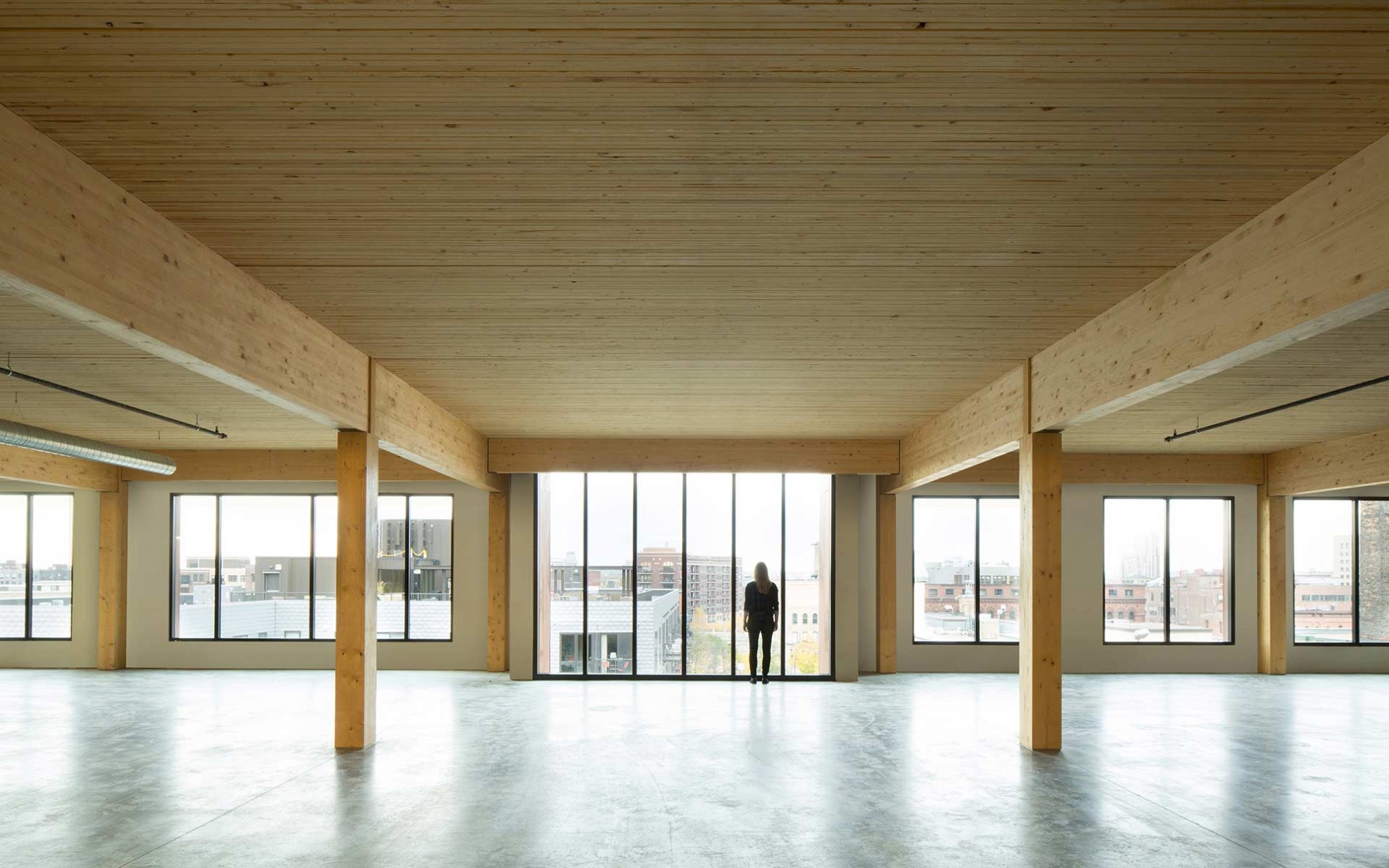
Cross-laminated timber (CLT) construction is changing the building industry by offering a sustainable, efficient, and versatile alternative to traditional materials like steel and concrete. CLT is an engineered wood product made by gluing together layers of solid-sawn lumber, with each layer placed perpendicular to the one below. This cross-lamination makes the panels strong and rigid, making them useful for everything from homes to large commercial buildings. CLT supports environmentally friendly construction by reducing the carbon footprint of building materials and promoting the use of renewable resources.
CLT offers more than just environmental benefits. Its prefabricated panels allow for quick assembly on-site, cutting down on construction time and labor costs. The lightweight yet strong panels enable innovative architectural designs and flexible building layouts. CLT also has excellent fire resistance, soundproofing, and insulation properties.
This article explores the design and construction of timber structures using cross laminated timber (CLT).
History of CLT Use
Developed in Europe in the 1970s, CLT is an engineered wood panel product that has seen continuous advancement, particularly in Austria and Germany. As a large-volume wood panel construction, CLT is an ideal choice for projects requiring low-embodied-carbon materials or aesthetically pleasing, dimensionally stable exposed timber finishes. It has expanded the feasible height range for timber-framed structures (Figure 1) and is also used for shear walls in open-plan timber frame structures.

CLT is currently imported into the UK from mainland Europe. However, as the market in the UK grows, local production from domestic timbers may become viable. Research and feasibility studies have already been conducted on manufacturing CLT in the UK from Scottish-grown Sitka spruce. North America is also witnessing a rapid expansion in the structural use of CLT, supported by numerous harmonized standards and design guides. Although the UK lacks a specific design guide, TRADA is developing guidelines to support the local design industry.
Overview of CLT
CLT panels are composed of a minimum of three cross-bonded layers of timber, with thicknesses ranging from 20mm to 45mm. The timber is strength-graded to BS EN 14081-1:2005 and glued together under pressure. These panels have an odd number of layers (3, 5, 7, or 9) arranged symmetrically, with each adjacent layer’s grain direction at right angles (Figures 2 ). The overall thickness and load-bearing capacity of the composite panel depend on the individual laminates’ build-up, with common thicknesses ranging from 80mm to 200mm.
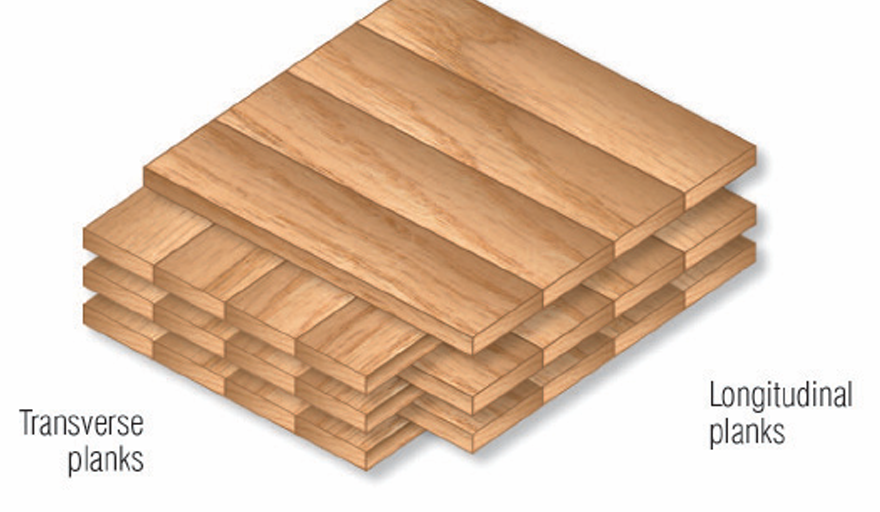
Applications of CLT
CLT panels are utilized in various structural applications, including walls, roofs, floors, and stairs. The building envelope can be insulated and clad with materials such as timber, brick, render, or composite panels. CLT structures up to eight storeys have been built in the UK, and current knowledge supports designs up to 12 storeys. Research has even explored the feasibility of constructing timber structures up to 30 storeys tall using CLT. Figure 1 illustrate how CLT enhances timber’s potential in structures traditionally built with other materials.
Structural Configurations
CLT panels can be applied in multiple configurations. They can be used as pre-insulated wall and roof cassettes, though care must be taken to avoid damaging the insulation during transit. For instance, room-in-the-roof construction can utilize prefabricated CLT panels for roofs with simple continuous ridges and gable ends. A warm roof construction can be created by placing a breathable roof underlay and rigid insulation above the CLT panels, forming insulated cassettes.
CLT sloping roof panels are typically supported by external walls, eaves, purlins, and ridge beams. However, coupled roofs can also be formed to create clean structural ceiling lines, provided resistance to horizontal forces is managed at the eaves. CLT panels transfer vertical and horizontal loads to walls, purlins, and ridge beams through engineered mechanical fixings.
Platform-Frame Construction
CLT structures are often built using a platform frame approach, where walls are temporarily braced before floor panels are lowered and fixed onto them. This completed floor structure serves as a platform for erecting wall panels for subsequent storeys. Figure 3 depicts a typical multistory CLT construction, while Figure 4 illustrates a CLT platform-frame external wall-floor junction. Floor structures are usually arranged as one-way spanning slabs, although computer-aided analysis can utilize the two-way spanning capabilities of large slabs.

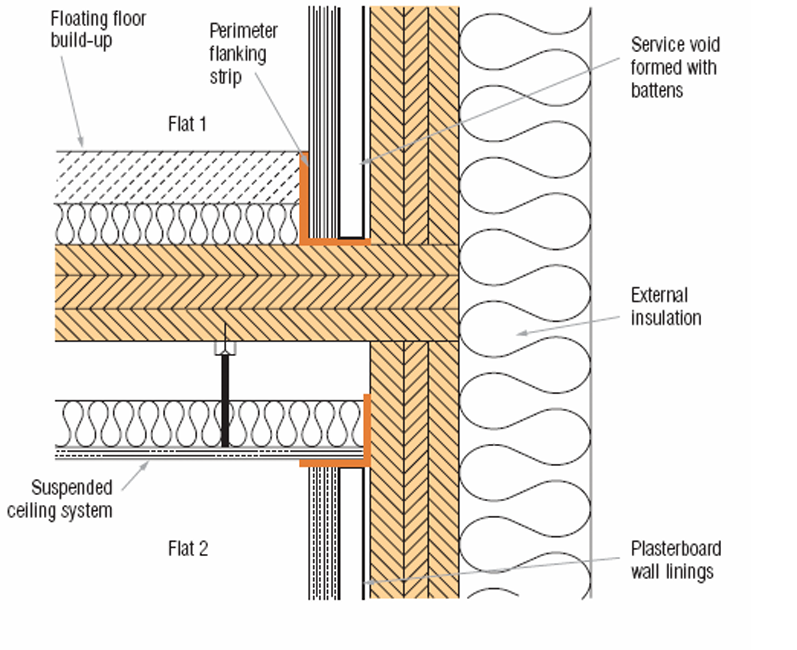
Figure 4 Typical CLT platform-frame external wall–floor junction2Hybrid Forms of CLT Construction
Combining CLT with platform-frame timber frames can enhance structural efficiency. One method involves using external non-loadbearing walls with highly insulated panels. In this configuration, CLT floor slabs span parallel to the external walls, allowing for highly insulated non-loadbearing infill panels (Figure 5). This is suitable for regular cross-wall arrangements that provide the load-bearing structure while achieving high thermal performance from the external walls.
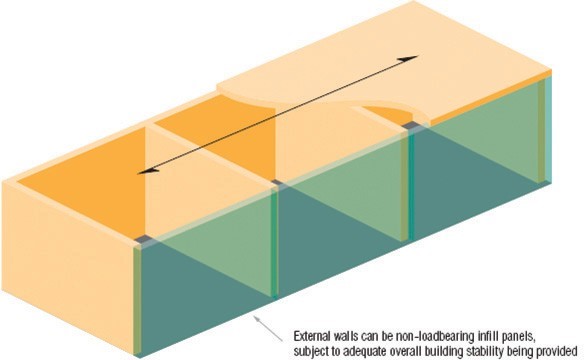
Timber-frame walls or concrete/masonry basements can support CLT floor slabs where a thin floor section or exposed soffit is needed. Similarly, CLT wall panels can be combined with joisted or concrete floor structures for aesthetic purposes. For low-rise construction, the load-bearing capacity of CLT wall panels may not offer significant benefits over conventional stud-framed walls.
Engineered timber floor joists can also be paired with CLT wall panels where a lightweight floor/roof structure is preferred, or exposed CLT wall panels are desired. These timber floor structures can be supported on top of (platform-frame approach) or inside of (balloon-frame approach) CLT wall panels. Figure 6 depicts an engineered I-joist floor structure in a balloon-frame configuration.
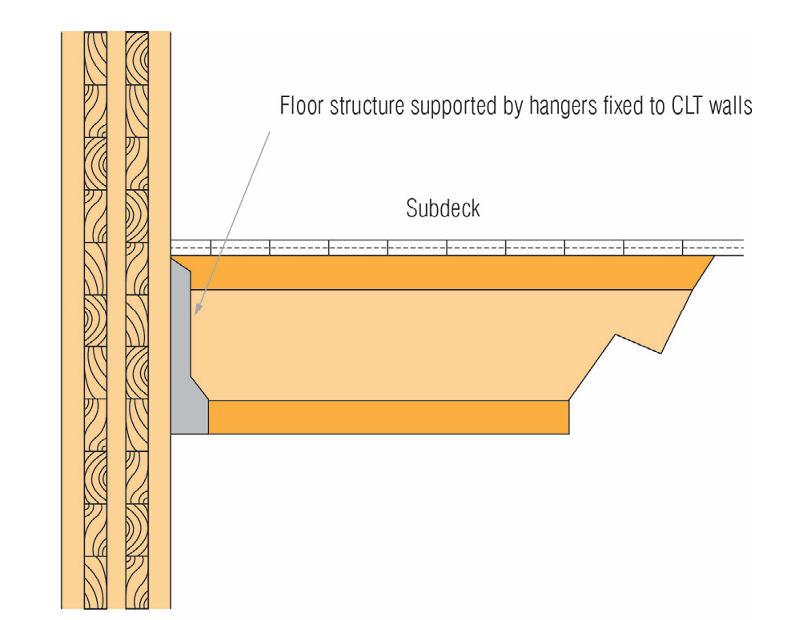
When engineered timber joists are built into CLT wall panels in a platform-frame approach, vertical load transfers through the floor zone using timber ring beams and solid timber blocking between joists (Figure 7). Engineered timber products like laminated veneer lumber (LVL) or laminated strand lumber (LSL) minimize shrinkage across the floor zones. Alternatively, top chord supported open web joists can eliminate the need for solid blocking beneath walls (Figure 8).
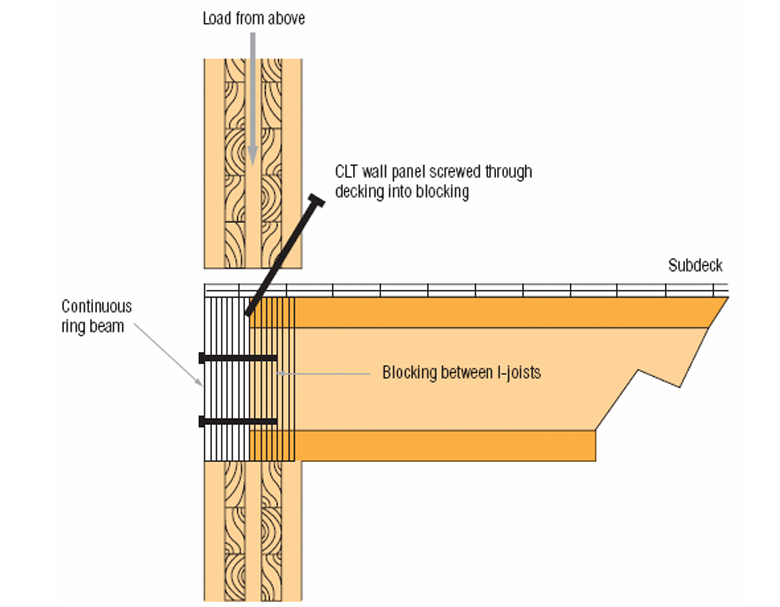
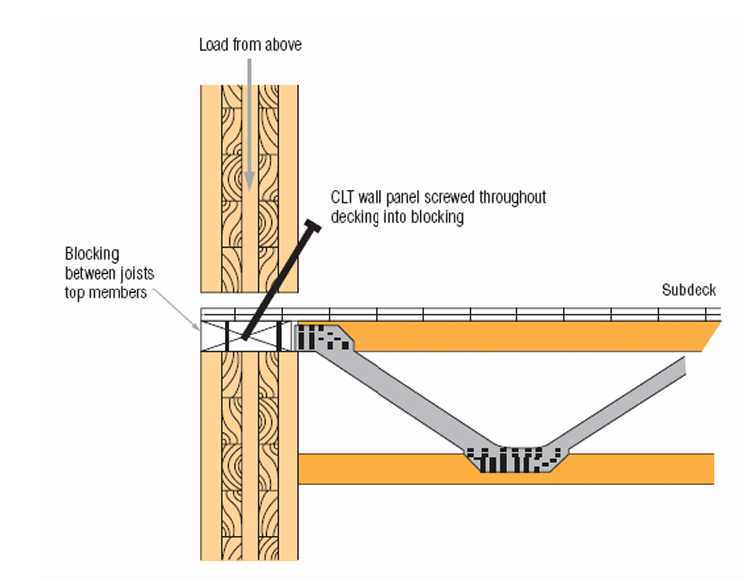
Figure 11Figure 8: Wall–joist detail – platform-frame method using top-chord supported joists
TRADA Guidance Document 10 (GD10) compares the relative stiffness and self-weights of various engineered timber floor structures. CLT floor slabs can also form wood/concrete composite floors, where the CLT slab acts as permanent formwork, with horizontal shear transfer provided by shear plates and screws. CLT walls can support precast concrete floors for increased thermal mass.
CLT floor slabs can be supported by glulam or steel frames, creating large open-plan areas. This method is suitable where load bearing CLT walls are impractical or would add unnecessary weight (Figure 9 ).
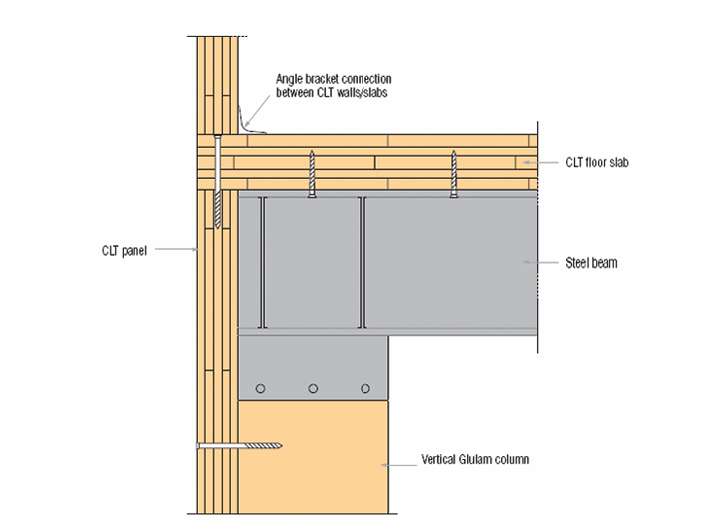
Hybrid CLT Products
Hybrid CLT products like Leno® Plus (MERK) incorporate a central layer of 32mm LVL, eliminating panel joints.
Benefits to Construction Process of Using CLT
Using prefabricated CLT wall and floor panels offers several advantages:
- Improved Dimensional Stability: Cross-laminating enhances dimensional stability compared to sawn timber, allowing for prefabrication of long, wide floor slabs, single-storey walls, and tall wall panels.
- Rapid Construction: Prefabrication facilitates quick construction, reliable on-site programming, and ease of dismantling at the end of its service life.
- Robustness: CLT panels are inherently robust during transport and construction, resulting in fewer defects.
- Fewer Mechanical Fixings: Large, prefabricated panel elements reduce the need for on-site mechanical fixings.
- No Wet Trades Required: CLT structures are assembled with lightweight power tools, though cranes are needed to lift the panels.
- Ease of Fixing Materials: Cladding materials, services, and fittings can be easily attached to CLT walls using woodscrews.
- Low Noise and Disruption: The relatively low noise and disruption on a CLT site are advantageous for infill sites where the impact on neighbors is a concern.
- Sustainability: Made from renewable resources, CLT systems are desirable for their sustainability. CLT buildings have a low carbon footprint, as the wood locks away the carbon absorbed during growth, potentially resulting in carbon-negative construction.
Structural Benefits of CLT
CLT offers significant structural benefits over conventional softwood wall framing and joisted floor constructions. It provides high axial and flexural load-bearing capacity, excellent in-plane shear strength, fire resistance for exposed applications, and superior acoustic properties.
As a solid wall panel, CLT distributes concentrated loads as line loads at the foundation level, reducing the need for localized pad foundations. The cross-laminations in CLT significantly increase splitting resistance for certain dowel-type fasteners. Problematic end-grain connections are avoided since there is always a layer of cross-grain to fix into. Designers will find working stresses low due to the large cross-sections.
Compared to traditional platform timber-frame construction, CLT offers several advantages:
- High Axial Load Capacity: Due to the bearing area of load-bearing elements.
- High In-Plane Shear Strength: To resist horizontal loads.
- Significant Deadweight: To resist overturning forces, reducing the need for mechanical holding-down resistance.
- Inherent Fire Resistance: Due to the large section size compared to timber-frame walls. A charred layer forms on the CLT surface during a fire, insulating the remaining section and retaining its load-bearing capacity.
- Slimmer Floors: CLT slabs require slimmer floors than joisted timber solutions.
- Ease of Structural Fixings: Edge distances are less likely to be an issue, making structural fixings easier to provide and more likely to achieve their design capacity.
Thermal and Acoustic Performance
CLT offers excellent thermal insulation and sound insulation properties. It contributes to the overall ‘U’ value of the building envelope (Figure 10) and has a thermal conductivity of 0.13W/mK. This low thermal conductivity makes CLT effective in cantilevered slab situations or other partially exposed areas where thermal bridging occurs. For wall panels at least 85mm thick, airtightness can be achieved without additional sealing strips by gluing joints and reveals during erection.
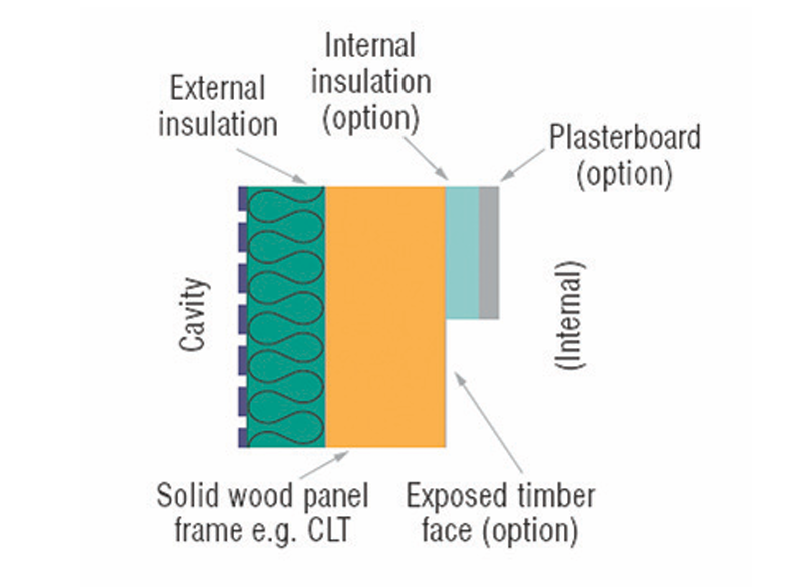
Conclusion
Cross-laminated timber (CLT), developed in Europe in the 1970s, has significantly advanced timber construction with its sustainable and versatile properties. Comprising multiple cross-bonded timber layers, CLT offers high load-bearing capacity, enhanced dimensional stability, and excellent fire resistance. It is widely used in walls, roofs, floors, and stairs, supporting structures up to 12 storeys and potentially even 30 storeys. Prefabricated CLT panels facilitate rapid construction, reduce defects, and minimize on-site mechanical fixings, making them ideal for large-scale projects.
The versatility of CLT extends to hybrid constructions, combining with timber-frame walls, concrete or masonry basements, and glulam or steel frames. This adaptability, along with improved thermal and acoustic performance, positions CLT as a preferred material for modern construction. Its sustainability, low carbon footprint, robustness during transport and construction, and ease of fixing materials enhance its appeal. Overall, CLT merges traditional timber benefits with modern engineering to offer efficient, high-performance, and eco-friendly building solutions.
See: Building Tall with Timber: Does it Make Sense?
- Crawford D., Hairstans R. and Smith R. E. (2013) ‘Feasibility of cross-laminated timber production from UK Sitka spruce’, COST Action FP1004: European Conference on Cross Laminated Timber (CLT), Graz, Austria, 21–22 May
- UK Timber Frame Association (2014) ‘Timber Engineering Notebook No. 11: Cross-laminated timber construction – an introduction ’, The Structural Engineer, 91 (4), pp. 44–50